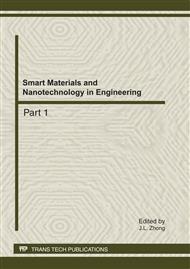[1]
Nel A, Xia T, Madler L, Li N (2006) Science 311: 622–627.
Google Scholar
[2]
Deposition model[ M ] & International Commission on Radiological. Protection ICRP Publication 66: Human Respiratory Tract Model for Radiologica l Protection. Annals of the ICRP Volume 24 ( 1-3) . E lsevier (1995).
DOI: 10.1093/annhyg/38.inhaled_particles_vii.251
Google Scholar
[3]
O berdorster G, F inkelstein JN, John ston C G elein R, Cox C, Baggs R, e t a l A cute pu l onary effects of ultrafine part icles imrats and m ice[ J] . R es R ep H eal th Eff Inst 2000 ( 96) : 5 - 74disc 75- 86.
Google Scholar
[4]
Halliwell B, Gutteridge JMC (2007) Free radicals in biology and medicine. Oxford University Press, New York.
Google Scholar
[5]
Knaapen AM, Seiler F, Schilderman PAEL, Nehls P, Bruch J, Schins RPF, Borm PJA (1999) Free Radic Biol Med 27: 234–240.
DOI: 10.1016/s0891-5849(98)00285-8
Google Scholar
[6]
Evans DE, Dizdaroglu M, Cooke MS (2004) Mutat Res 567: 1–61.
Google Scholar
[7]
Karlsson HL, Cronholm P, Gustafsson J, Moller L (2008) ChemRes Toxicol 21: 1726–1732.
Google Scholar
[8]
Mroz RM, Schins RPF, Li H, Jimenez LA, Drost EM, HolowniA, MacNee W, Donaldson K (2008) Eur Respir J 31: 241–251.
DOI: 10.1183/09031936.00006707
Google Scholar
[9]
Mroz RM, Schins RPF, Li H, Drost EM, Macnee W, DonaldsonK (2007) J Physiol Pharmacol 58: 461–470.
Google Scholar
[10]
Yang H, Liu C, Yang DF, Zhang HS, Xi ZG (2009) J Appl Toxicol 29: 69–78.
Google Scholar
[11]
Zhong BZ, Whong WZ, Ong TM (1997) Mutat Res GenetToxicol Environ Mutagen 393: 181–187.
Google Scholar
[12]
Tice RR, Agurell E, Anderson D, Burlinson B, Hartmann A, Kobayashi H, Miyamae Y, Rojas E, Ryu JC, Sasaki YF (2000)Environ Mol Mutagen 35: 206–221.
DOI: 10.1002/(sici)1098-2280(2000)35:3<206::aid-em8>3.0.co;2-j
Google Scholar
[13]
Johansson C, Moller P, Forchhammer L, Loft S, Godschalk RWL, Langie SAS, Lumeij S, Jones GDD, Kwok RWL, AzquetaA, Phillips DH, Sozeri O, Routledge MN, Charlton AJ, Riso P, Porrini M, Allione A, Matullo G, Palus J, Stepnik M, CollinsAR, Moller L (2009).
DOI: 10.1093/mutage/gep055
Google Scholar
[14]
Devanaboyina US, Gupta RC. Sensitive detection of 8-hydroxy-2'deoxyguanosine in DNA by 32p-postlabeling assay and the basal levels in rat tissues [j]. carcinogenesis, 1996, 17(5): 917-924.
DOI: 10.1093/carcin/17.5.917
Google Scholar
[15]
Halliwell B, Gutteridge JMC (2007) Free radicals in biology and medicine. Oxford University Press, New York.
Google Scholar
[16]
Lam, C. W., James, J. T., McCluskey, R., and Hunter, R. L. (2004). Pulmonary toxicity of single-wall carbon nanotubes in mice 7 and 90 days after intratracheal instillation. Toxicol. Sci. 77, 126–134.
DOI: 10.1093/toxsci/kfg243
Google Scholar
[17]
Ma-Hock, L., Treumann, S., Strauss, V., Brill, S., Luizi, F., Mertler, M., Wiench, K., Gamer, A., van Ravenzwaay, B., and Landsiedel, R. (2009).
DOI: 10.1093/toxsci/kfp146
Google Scholar
[18]
Dockery, D., Pope, C. A., Xu, X., Spengler, J. D., Ware, J. H., Fay, M. E., Ferris, G. G., and Speizer, F. E. (1993). An association between air pollution and mortality in six US cities. N. Engl. J. Med. 329, 1753–1759.
DOI: 10.1056/nejm199312093292401
Google Scholar
[19]
Pacurari M, Yin XJ, Ding M, Leonard SS, Schwegler-Berry D, Ducatman BS, Chirila M, Endo M, Castranova V, Vallyathan V 2008) Nanotoxicology 2: 155–170.
DOI: 10.1080/17435390802318356
Google Scholar
[20]
Yang K, Wan J, Zhang S, Zhang Y, Lee ST, Liu Z. In vivo pharmacokinetics, long-term biodistribution, and toxicology of PEGylated graphene in mice. ACS Nano. 2011 Jan 25; 5(1): 516-22. Epub 2010 Dec 16.
DOI: 10.1021/nn1024303
Google Scholar


